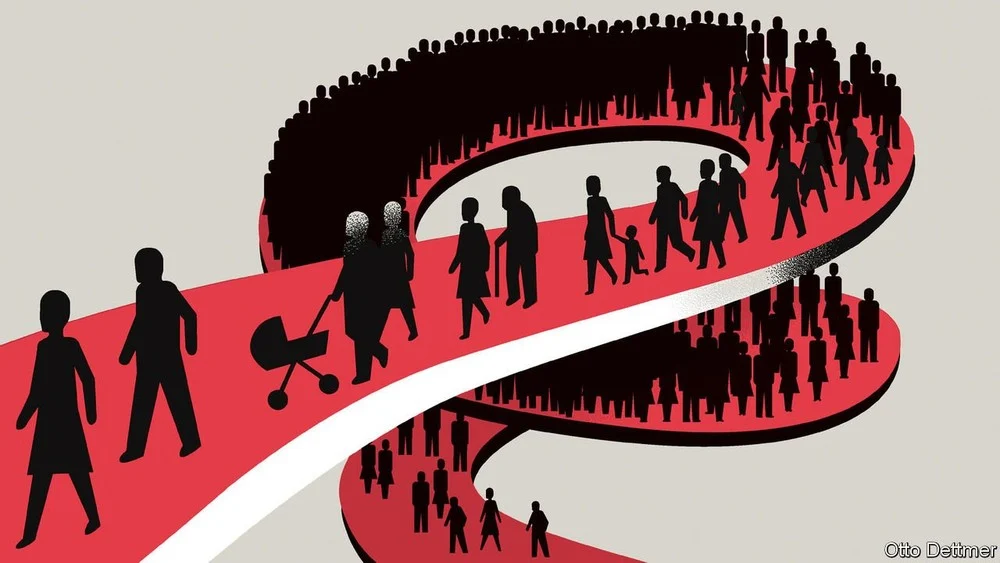AS BIRTH ANNOUNCEMENTS go, it was momentous. On November 24th India’s government declared that the country’s fertility rate had dropped to 2.0 children per woman. That is below the replacement rate—at which new births are sufficient to maintain a steady population—and puts India in the company of many richer economies. Indeed, fertility rates are now below replacement level in all four “ bric” countries (Brazil, Russia, India and China), with the population probably falling in Russia and China. It is no surprise that emerging economies should follow a demographic trajectory similar to that travelled by rich economies before them. But the pace of change seems to be accelerating, with potentially profound implications for the global economy.
What social scientists refer to as the “demographic transition” has long been an essential feature of economic modernisation. In pre-industrial societies both birth and death rates (annual births and deaths per 1,000 people) were very high, and overall population growth was uneven and slow. But in the 18th century, death rates in parts of north-west Europe began to decline, marking the first stage of a seismic demographic shift. Falling death rates led to rapid population growth; Britain’s population roughly doubled between 1760 and 1830. Yet from the late 18th century, fertility rates began to decline as well. By the 20th century, birth and death rates in rich countries stabilised at low levels, leading to slow or even negative population growth in the absence of immigration.
Transitions are complex social phenomena. Falling death rates are easiest to explain, as the product of improved nutrition, medicine and public health. Falling birth rates are in part a response to economic incentives. As the return to skill increases, for example, families seem to have fewer children in order to invest more in each child’s education. But culture matters, too. In a recent paper, Enrico Spolaore of Tufts University and Romain Wacziarg of the University of California, Los Angeles, note that in Europe, new fertility norms first emerged in France in the late 18th and early 19th century. The fashion for fewer births was probably rooted both in changes in outlook associated with secularism and the Enlightenment and in the spread of information about family planning. As birth rates fell across Europe, they did so faster and earlier in places with linguistic and cultural ties to France.
Demographic transitions today follow fairly similar patterns, reckon Matthew Delventhal of Claremont McKenna College, Jesús Fernández-Villaverde of the University of Pennsylvania and Nezih Guner of the Universitat Autònoma de Barcelona, in another new paper. The authors gather data on 186 countries, and find that all but 11 have experienced the transition to lower, more stable death rates that are well below pre-industrial norms. A bevy of about 70 countries began their transition towards low fertility rates between 1960 and 1990. Only one country—Chad—has yet to begin a fertility transition. (In 80 countries, both mortality and fertility shifts towards modern lows are now complete.)
Importantly, the pace at which countries undergo a demographic transition seems to have sped up. While Britain’s transition unfolded in a leisurely fashion between the 1790s and the 1950s, Chile’s occurred more briskly between the 1920s and the 1970s, and those begun towards the end of the 20th century have taken only a few decades. This acceleration seems at least partly to reflect what the authors call “demographic contagion”, or the fact that transitions occur sooner and faster where geographically and culturally proximate places have already undergone a fertility shift. This proximity effect may also mean transitions now start at lower income levels. Whereas fertility transitions over the past two centuries tended to begin at gdp per person of about $2,700 (on a purchasing-power-parity basis and in 2011 prices), those begun since 1990 occurred at an income level of around $1,500.
The upshot of this rush into the demographic transition is a steady drop in global fertility and population growth. The world’s fertility rate, which stood at 3.5 births per woman in the mid-1980s, fell to just 2.4 in 2019. Indeed it is possible, given observed declines in rich-world births during the pandemic, that covid-19 may have pushed the world as a whole within sight of a replacement-level fertility rate, if only temporarily. The world’s population will continue to grow even after that level is attained, because of the large number of people either at or approaching child-rearing age. India’s population, for example, is still expected to rise to about 1.6bn by mid-century. But that is a lower peak (by about 100m people) reached sooner (by about a decade) than previously expected. Similarly, the rapid decline in global fertility may mean that projections by the un, which show the global population rising towards 11bn by 2100, will ultimately have to be revised downwards.
Old money
The global completion of the demographic transition will not be without its headaches. It may complicate long-run macroeconomic problems, for example, or so suggests recent work by Adrien Auclert and Frédéric Martenet of Stanford University, Hannes Malmberg of the University of Minnesota and Matthew Rognlie of Northwestern University. They note that increased saving by ageing populations depresses inflation and interest rates. As the share of world population over 50 rises from 25% today to 40% in 2100, low interest rates may become more entrenched, returns on assets could drop and global imbalances widen.
Yet demographic transitions could also bring a range of economic benefits. Slower population growth could make the challenge of cutting carbon emissions less daunting. And the potential of the fewer workers around might be better realised, through better education and more women participating in the labour force. The arrival of immigrants, once viewed as a threat, could even become as momentous an occasion as a birth in the family.
By The Economist





